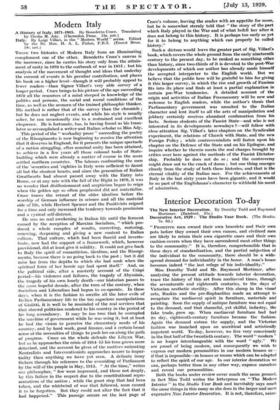Interior Decoration To-day
"PRIMITIVE men owned their own bracelets and their own pots before they owned their own canoes, and civilized men are likely to retain their own cigarette cases and their own cushion-covers when they have surrendered most other things to the community." It is, therefore, comprehensible that in these days of standardization, and the partial subjection of the individual to the community, there should be a wide- spread demand for individuality in the home. A man's house becomes indeed " the last refuge of his individuality."
Miss Dorothy ,Todd and Mr. Raymond Mortimer, after analysing the present attitude towards interior decoration, trace the history of this art from mediaeval times, through the seventeenth and eighteenth centuries, to the days of Victorian aesthetic sterility. After this slump in the visual arts, Ruskin and the pre-Raphaelites made an attempt to recapture the mediaeval spirit in furniture, materials and painting. Soon the supply of antique furniture was not equal to the demand, and that shameful, yet skilful, industry, the fake trade, grew up. When mediaeval furniture had had its day, eighteenth-century- furniture became the 'fashion. Again the demand outran the supply, and the Victorian
fashion was launched upon an uncritical and artistically impotent world. To-day, however, we live very consciously in the first half of the twentieth century. The word modern " is no longer interchangeable with the word " ugly." We are proud of being modern, and consequently we wish to
express our modern personalities in our modern houses or-- if that is impossible--in houses or rooms which can be adapted
to reflect the spirit of our age. In our interior decoration we
can, perhaps better than in any other way, express ourselves and reveal our personalities.
Both the books under review cover much the same ground, in fact Miss Todd writes the letterpress on " The Modern Interior " in the Studio Year Book and inevitably says much the same things in this essay as she does in the larger and more expensive New Interior Decoration. It is not, therefore, neces-
'nary to discuss these two books separately. Both are excel- lent : the one will appeal to a richer public and the other to a poorer.
It is encouraging and, we think, true that we are in the midst of a renaissance of the decorative arts. A new style— our own style—is developing, and in these two books an attempt is made to define this style. The keynotes of it appear to be simplicity, form, and suitability for purpose ; and, of the three, the last is perhaps the most stressed, as it should be in our mechanical age. " We want to sit in the sun, to get along without servants, or housemaids' knees and stays, and layer upon layer of petticoats. The Romantic movement has had its day." And in order to attain this life we must eliminate all unessentials. The principle has also been realized that " the* more closely the form of an object fits its use, the more economic will be its manufacture, and at the same time, the less likely it is to be ugly," The beauty of perfect utility is to-day recognized. - But the authors of these books do not confine themselves to the theory of decorative art, they give many suggestions as to how the theory is to be interpreted in practice, and they illustrate their suggestions with an enormous number of photographs, so that it is possible to see for ourselves the effect of a certain treatment or design. Most of the illustrations are of the work of French, German, and Dutch decorators, for in England we do not often lead the way in art, and, at any rate, we are more elastic in our interior decoration. We- make the best of a situation, without much thought to theory. In spite of our rather haphazard methods of interior decoration it is as well to be aware of a working theory. And the two books under review will adequately supply this need, as well as stimulate the reader to more enterprising and original efforts.

































 Previous page
Previous page